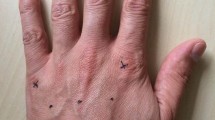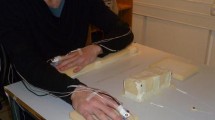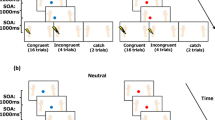Abstract
Several behavioural studies have shown that directing one’s gaze at a body part reduces detection speed and enhances discrimination of tactile stimuli at that location. We investigated how vision of a body part stimulated and manipulations of gaze direction affect tactile processing. Participants’ gaze was directed to one of their hands, with vision of this hand either available or prevented in different experiments. They had to detect infrequent tactile targets among non-targets. Somatosensory event-related brain potentials were recorded in response to stimulation of the hand towards which gaze was directed (G+ trials) and in response to stimulation of the other hand (G– trials). When vision (V+) of the hand gaze was directed at was available (G+V+), an early positivity overlapping with the P45 and N80 component was observed for G+V+ trials relative to G–V– trials. In contrast, when the hands were occluded from view (V–), an enhanced N140 component followed by a late negativity was observed for G+V– as compared to G–V– trials. It is suggested that vision of the body part stimulated can modulate processing in primary somatosensory cortex (S1), while effects of gaze direction in the absence of vision of the body part touched are located in higher order somatosensory areas. Such effects of vision and gaze on tactile processing may be mediated by pathways from multimodal brain regions to somatosensory cortex.





Similar content being viewed by others
References
Allison T, McCarthy G, Wood CC (1992) The relationship between human long-latency somatosensory evoked potentials recorded from the cortical surface and from the scalp. Electroencephalogr Clin Neurophysiol 84:301–314
Barba C, Frot M, Valeriani M, Tonali P, Mauguière F (2002) Distinct fronto-central N60 and supra-sylvian N70 middle-latency components of the median nerve SEPs as assessed by scalp topographic analysis, dipolar source modelling and depth recordings. Clin Neurophysiol 113:981–392
Calvert GA, Brammer MJ, Bullmore ET, Campbell R, Iversen SD, David AS (1999) Response amplification in sensory-specific cortices during crossmodal binding. Neuroreport 10:2619–2623
Driver J, Grossenbacher PG (1996) Multimodal spatial constrains on tactile selective attention. In: Inui T, McClelland JL (eds) Attention and performance XVI: integration in perception and communication. MIT Press, Cambridge, Mass., pp 209–235
Eimer M, Driver J (2000) An event-related brain potential study of cross-modal links in spatial attention between vision and touch. Psychophysiology 37:697–705
Eimer M, Forster B (2003a) Modulations of early somatosensory ERP components by transient and sustained spatial attention. Exp Brain Res 151:24–31
Eimer M, Forster B (2003b) The spatial distribution of attentional selectivity in touch: Evidence from somatosensory ERP components. Clin Neurophysiol 114:1298–1306
Eimer M, Cockburn D, Smedley B, Driver J (2001) Cross-modal links in endogenous spatial attention are mediated by common external locations: evidence from event-related brain potentials. Exp Brain Res 139:398–411
Eimer M, Van Velzen J, Driver J (2002) Crossmodal interactions between audition, touch and vision in endogenous spatial attention: ERP evidence on preparatory states and sensory modulations. J Cogn Neurosci 14:254271
Eimer M, Forster B, Fieger A, Harbich S (2004) Effects of hand posture on preparatory control processes and sensory modulations in tactile spatial attention. Clin Neurophysiol 115:596–608
Frot M, Mauguière F (1999) Timing and spatial distribution of somatosensory responses recorded in the upper bank of the sylvian fissure (SII area) in humans. Cereb Cortex 9:854–863
García-Larrea L, Lukaszewicz AC, Mauguière F (1995) Somatosensory responses during selective spatial attention: the N120-to-N140 transition. Psychophysiology 32:526–37
Graziano SMA, Cooke DF, Taylor CSR (2000) Coding the location of the arm by sight. Science 290:17821786
Hesse CW, Seiss E, Bracewell RM, Praamstra P (2004) Absence of gaze direction effects on EEG measures of sensorimotor function. Clin Neurophysiol 115:2938
Honoré J, Bourdeaud’hui M, Sparrow L (1989) Reduction of cutaneouse reaction time by directing eyes towards the source of stimulation. Neuropsychologia 27:367–371
Hötting K, Rösler F, Röder B (2003) Crossmodal and intermodal attention modulates event-related brain potentials to tactile and auditory stimuli. Exp Brain Res 148:26–37
Iwamura Y (2003) Somatosensory association cortices. Int Cong Ser 1250:3–14
Kennett S, Taylor-Clarke M, Haggard P (2001) Noninformative vision improves the spatial resolution of touch in humans. Curr Biol 11:1188–1191
Macaluso E, Frith CD, Driver J (2000) Modulation of human visual cortex by crossmodal spatial attention. Science 289:1206–1208
McDonald JJ, Teder-Salejarvi WA, Hillyard SA (2000) Involuntary orienting to sound improves visual perception. Nature 407:906–908
Michie PT (1984) Selective attention effects on somatosensory event-related potentials. Ann N Y Acad Sci 425:250–255
Michie PT, Bearpark HM, Crawford JM, Glue LCT (1987) The effects of spatial selective attention on the somatosensory event-related potential. Psychophysiology 24:449–463
Press C, Taylor-Clarke M, Kennett S, Haggard P (2004) Visual enhancement of touch in spatial body representation. Exp Brain Res 154:238–245
Sathian K, Zangaladze A, Hoffman JM, Grafton ST (1997) Feeling with the mind’s eye. Neuroreport 8:3877–3881
Stein BE, Meredith MA (1993) The merging of the senses. MIT Press, Cambridge, Mass.
Taylor-Clarke M, Kennett S, Haggard P (2002) Vision modulates somatosensory cortical processing. Curr Biol 12:233–236
Tipper SP, Lloyd D, Shorland B, Dancer C, Howard LA, McGlone F (1998) Vision influences tactile perception without proprioceptive orienting. Neuroreport 9:1741–1744
Tipper SP, Phillips N, Dancer C, Lloyd D, Howard LA, McGlone F (2001) Vision influences tactile perception at body sites that cannot be viewed directly. Exp Brain Res 139:160–167
Van Velzen J, Forster B, Eimer M (2002) Temporal dynamics of lateralised ERP components elicited during endogenous attentional shifts to relevant tactile events. Psychophysiology 39:874–878
Acknowledgements
This research was supported by a grant from the Biotechnology and Biological Sciences Research Council (BBSRC). The authors thank Helge Gillmeister for technical assistance.
Author information
Authors and Affiliations
Corresponding author
Rights and permissions
About this article
Cite this article
Forster, B., Eimer, M. Vision and gaze direction modulate tactile processing in somatosensory cortex: evidence from event-related brain potentials. Exp Brain Res 165, 8–18 (2005). https://doi.org/10.1007/s00221-005-2274-1
Received:
Accepted:
Published:
Issue Date:
DOI: https://doi.org/10.1007/s00221-005-2274-1




